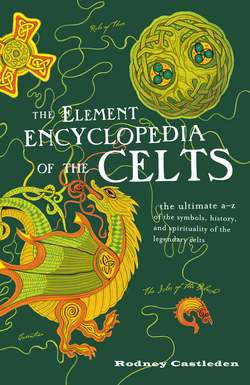Читать книгу The Element Encyclopedia of the Celts - Rodney Castleden - Страница 110
CULTURES
ОглавлениеThe central European Celts of the Iron Age had their origins in the Urnfield culture of the late Bronze Age. This had its beginnings in about 1300 BC, just 50 years before the Trojan War. It flourished at the same time as the great warrior-hero culture of the Mycenaeans and its growth may be connected with the decline of Mycenaean power.
As the name suggests, Urnfield was associated with a distinctive type of cemetery: large-scale cremation burials laid out in flat cemeteries, without burial mounds. These cemeteries were widespread over such a large area that archeologists have been confident in identifying the Urnfield people as proto-Celts, the immediate predecessors of the Celts.
The introduction of cremation (instead of the burial of the unburned body) suggests a change in beliefs regarding death and the afterlife. The use of large quantities of sheet bronze implies industrial-scale production of metal and reliable, well-organized trade routes to supply that industry. The sheet-bronze was used to make a variety of objects, including large vessels and shields. Sometimes the vessels were mounted on wagons for religious ritual.
The development of religious paraphernalia shows an increasingly complex religious symbolism and more integrated and uniform ways of expressing religious ideas.
Other changes were under way as well. By about 800 BC horses were used not just as draft animals but for riding. The horse became a symbol of the warrior elite, just as the horse-drawn chariot had been the symbol of the Mycenaean warrior heroes.
By 700 BC the Hallstatt culture had emerged out of Urnfield. This is the first of the classically recognized Celtic cultures. It was at Hallstatt, a picture-postcard lakeside village in Austria, that archeologists first identified new types of metal horse harness. The salt mines in the mountains were the basis of the prosperity and fame of this area between 700 and 400 BC. For the first time iron-working appears on a big scale. Hundreds of years before, the Mycenaeans evidently knew about iron, but they did not think of using it for tools or for weapon-making. The practice of iron-making was quickly copied at site after site. By 600 BC, the Atlantic Celts were making iron in Britain and Ireland.
The Hallstatt culture in central Europe has distinctive hallmarks. One is the rich burial of a warrior-prince or king in a timber mortuary-house, often with a four-wheeled wagon (sometimes in dismantled kit form), covered by a burial mound made of earth. Often in these burials there are three sets of horse-harness. The wagon-team would have comprised a pair of horses, just like a Mycenaean chariot, so what is the third set of trappings for? It is possible that it represented the prince’s or king’s personal steed: his charger.
The elite men, and sometimes women, buried in these opulent graves were rich enough to import wine from the Mediterranean lands.
By 500 BC the power centers had moved away from Austria, north and west toward the Rhineland and the Marne Valley in northern France. Changes in burial custom at the same time led archeologists to identify this development as a new culture: La Tène. The culture was named after a site in Switzerland, on the shore of Lake Neuchatel. La Tène means “The Shallows” and it was a location along the lakeshore that was seen as sacred: a fit place to leave offerings to please the gods. When the site was excavated in 1906–17, it yielded a rich haul of objects that were of new types, including iron swords and everyday ironwork.
There was still a warrior aristocracy and it still went in for burials with funerary carts, but now the carts were a more elegant two-wheeled type rather than the heavier four-wheeled type: a chariot more on the lines of the Mycenaean chariot; a two-wheeled vehicle was far more maneuverable. The old four-wheeled wagons were more the vehicles of fighting farmers; the new two-wheeled chariots were skillfully designed, showing collaboration between carpenters, blacksmiths, and wheelwrights to produce a professional fighting machine.
More arresting still, the accoutrements of the warrior-princes were elaborately decorated with what we now see as typical Celtic designs. The La Tène style is familiar to us: it is the root of all the later artwork that we recognize as Celtic. The S-shaped line that endlessly repeats suggests a variety of things, including rippling water and plant tendrils. But there are also surprises. In the middle of a swirl of lines we sometimes recognize an animal head, so stylized that we cannot be sure whether it is really there, intended by the artist-craftsman, or we ourselves are projecting it—like the giants or mountain landscapes we sometimes see in cloud formations. And here is a hint of the Celtic love of shapeshifting legends.
According to the threefold model for Iron Age Britain, a third wave of innovation came with a third lot of migrants, the Belgae, who arrived in south-east England late in the first century BC. The Belgic culture area extended from Belgium across northern France into south-east England. Distinctive objects associated with the Belgae in Britain were wheel-made pottery and Gallo-Belgic coins.
But this threefold model has been shaken by the general acceptance that there were no mass movements of people into Britain in the first millennium BC. There were no invasions, apart from Julius Caesar’s; instead we should think rather of a complex evolution of an indigenous culture.
